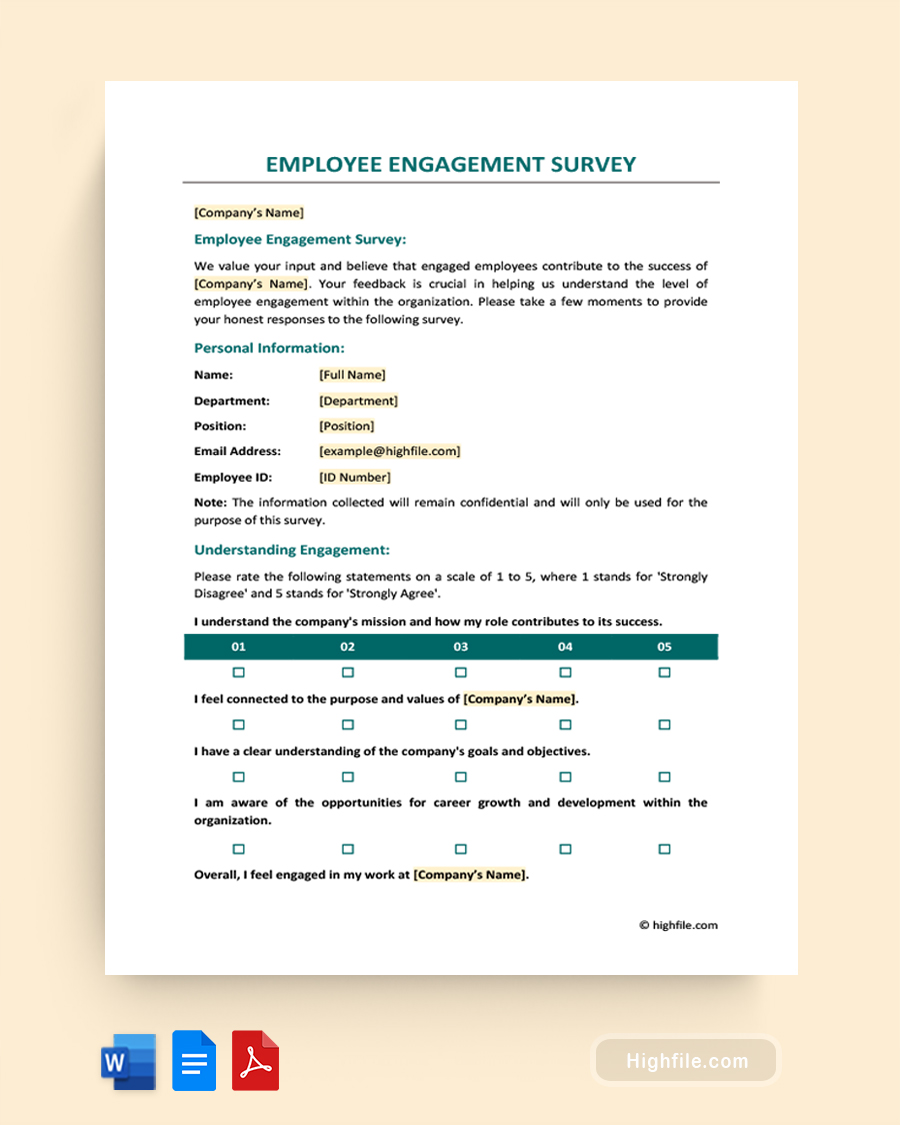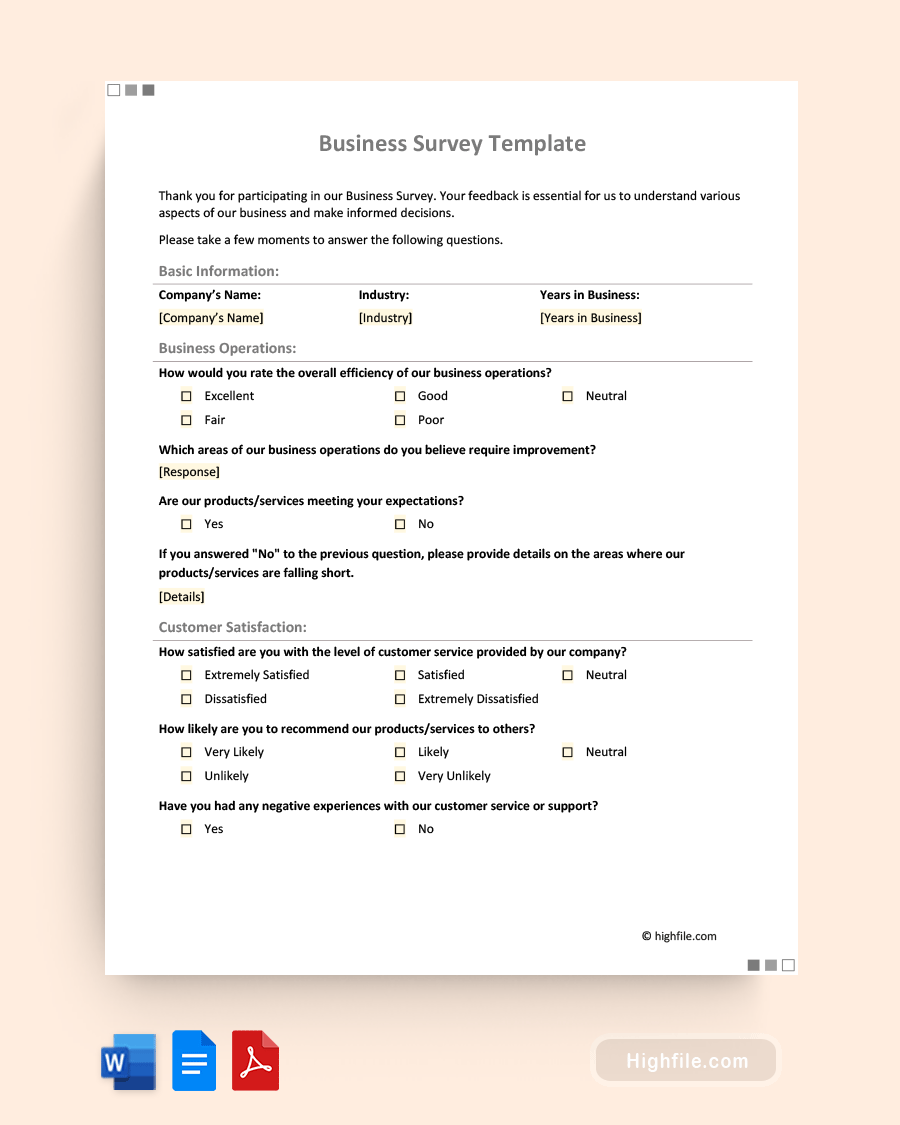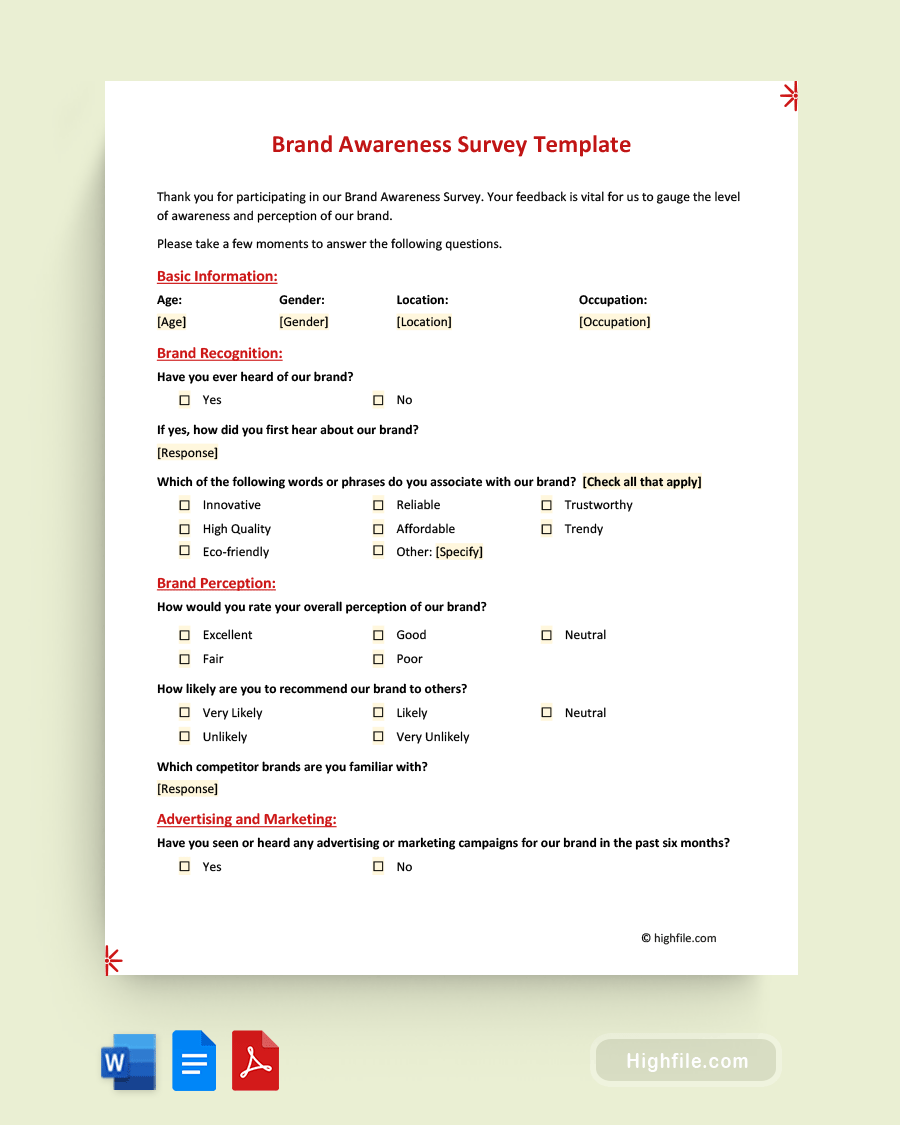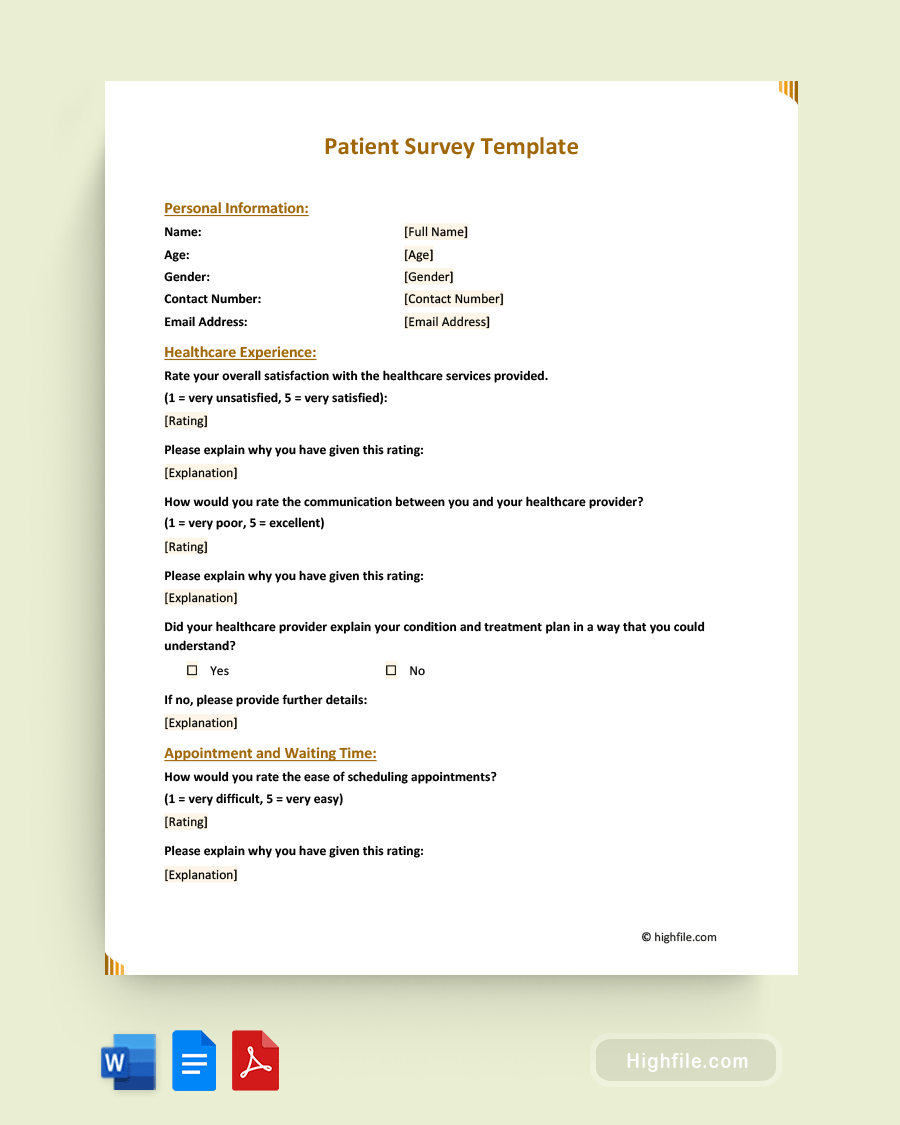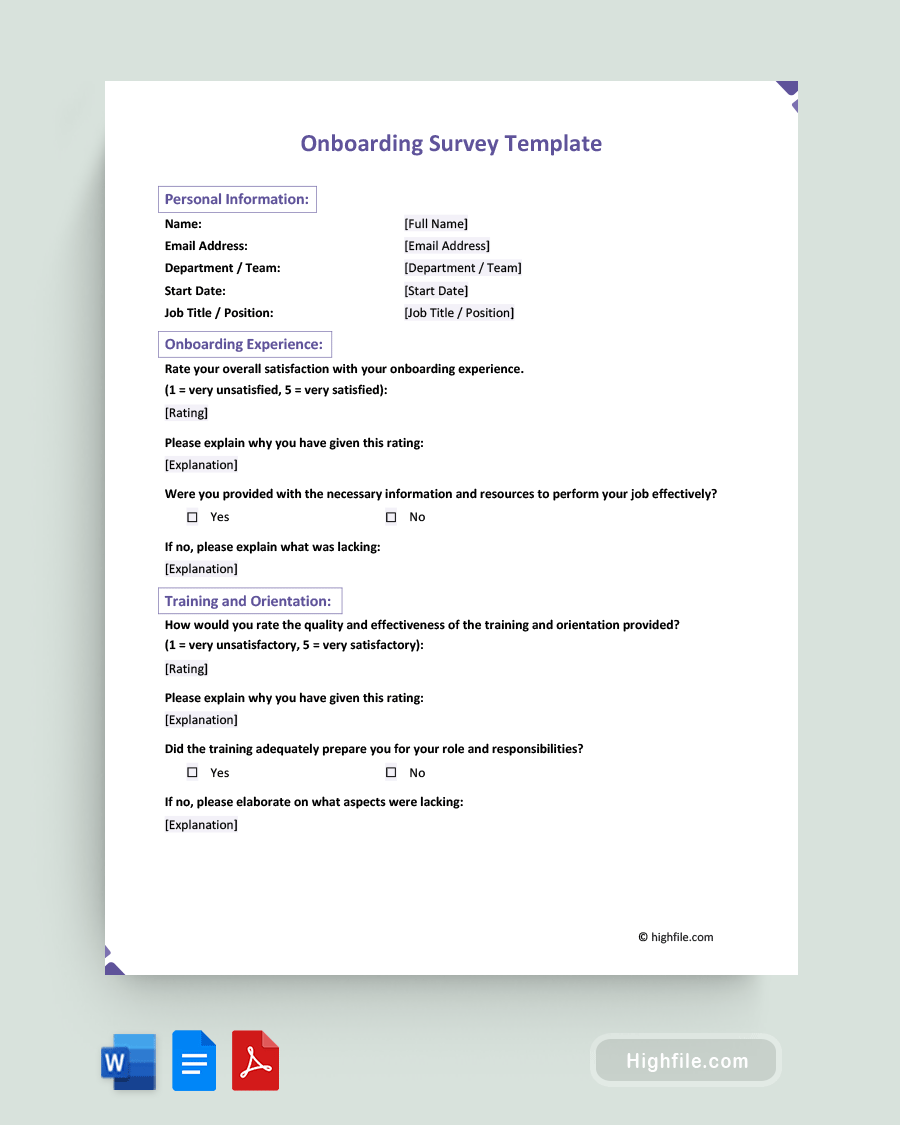Companies with dedicated, engaged employees tend to do better over time than those with disconnected and dissatisfied workers. Unhappy workers are more prone to quit or go on strike, but keeping track of how your workers feel, especially in a larger business, can be difficult. Luckily, you don’t need to guess or dedicate excessive amounts of paid time to going around and asking individually. Instead, you can use an Employee Engagement Survey Template to quickly and easily craft a high-quality, customized questionnaire that lets you get the necessary information while showing your employees you value them and their feedback. Read on, and we’ll show you how.
What Is an Employee Engagement Survey Template?
An employee engagement survey template is a structured questionnaire that measures the level of engagement and satisfaction among employees. It has a set of pre-defined questions and statements to rate. These cover various aspects of the employee experience, like their work environment, relationships with colleagues and managers, recognition, and overall job satisfaction. This template serves as a framework for customizing surveys to gather valuable feedback from employees that provides insights into their sentiments and helps companies identify areas for improvement so they can take action.
Why Is Employee Engagement Survey Template Important?
Employee engagement survey templates are important because they provide a systematic and standardized approach to measuring and understanding employee engagement levels. Here are the reasons why you need this helpful document:
- Assessment: The template helps organizations assess the current level of employee engagement. It also identifies areas of strength and weakness so you can create an action plan to address the necessary areas.
- Insights: With an employee engagement survey template, you can gain valuable insights into the factors contributing to employee engagement, so you can make informed decisions to enhance the overall employee experience.
- Benchmarking: Using your survey results, you can compare engagement levels across different departments, teams, or even industry benchmarks. This provides a baseline for improvement efforts.
- Actionable Data: The template helps collect quantitative and qualitative data. By reassessing annually, you can track changes over time, set measurable goals, and make data-driven decisions to improve engagement.
- Employee Voice: Organizations demonstrate their commitment to employee well-being by providing employees with a platform to voice their opinions, concerns, and suggestions.
- Structure: The template provides a jumping-off point that helps you craft a document that is specific to your company while also helping prevent common mistakes and keeping the questions to a reasonable length that prevents survey fatigue and wasted time.
Important Note: A high-quality Employee Engagement Survey Template is just the first step in the process. Follow through by analyzing the collected data, creating an action plan, and then communicating changes and improvements with your employees.
Essential Elements of Employee Engagement Survey Template
The essential elements of an Employee Engagement Survey Template help you organize and draft your questionnaire by providing a professional structure and recommended common formats and questions for each section. Below we’ve created an outline demonstrating each element and its purpose so you know what to expect when filling out and customizing your template.
- Form Title: Clearly indicate that the survey is focused on employee engagement. This sets the context for participants and ensures they know what this document is for.
- Company Name: This identifies the organization conducting the survey and is a standard part of most professional paperwork.
- Employee Engagement Survey Intent Statement: Provide a clear, concise explanation of the survey’s purpose and emphasize the importance of employee participation.
- Respondent Personal Information: This section is where the respondent includes their identification details (e.g., employee ID). It is typically followed by a note emphasizing the confidentiality of the responses to encourage honest feedback.
- Understanding Engagement: The first question section includes statements that employees rate on a scale of 1-5 to assess their level of engagement with their work.
- Relationship with Colleagues and Managers: This section uses the same rating system with statements to evaluate employees’ perceptions of their relationships with colleagues and managers.
- Work Environment and Job Satisfaction: Part three is rating statements regarding their work environment, job responsibilities, and overall job satisfaction.
- Employee Feedback and Recognition: Next, they rate statements about the frequency and effectiveness of employee feedback and recognition practices.
- Open Feedback: The fifth question section has open-ended questions that allow employees to provide additional comments, suggestions, or concerns beyond the predefined ratings.
- Appreciation and Company Contact Statements: End your survey by expressing appreciation for employee participation. Provides contact information for employees who may require further assistance or have questions and thank them directly for their time and assistance.
Pro Tip: Inclusivity and accessibility matter. Make sure your survey is genuinely available to all employees. For example, offering translated copies if your staff is multilingual or large text versions for easy reading can help you get the insights you need while demonstrating to your staff that all of them are valued.
FAQs
An employee engagement survey assesses employees’ emotional connection, commitment, and motivation toward their work and the business by exploring factors like job involvement, organizational commitment, and alignment with company values. Alternatively, an employee satisfaction survey measures employees’ overall satisfaction with more specific aspects of their job, like compensation, benefits, workload, and work-life balance. There is some overlap in the topics covered, but the employee engagement survey typically provides a more holistic view of the employee experience and their level of dedication.
How often you conduct employee engagement surveys depends on a number of factors, including company size and specific goals. That said, it is generally recommended to conduct surveys at least once a year to track engagement trends and identify areas for improvement. Regular surveys help you maintain a good handle on employee sentiment, drive continuous improvement, and demonstrate commitment to employee well-being.
Here are some recommendations to encourage employee participation in your survey:
· Communicate the survey’s purpose, benefits, and confidentiality to employees through multiple channels, such as emails, company newsletters, and team meetings.
· Offer incentives, like gift cards or entries into prize drawings.
· Make the survey easily accessible. Offer physical and digital options that have user-friendly interfaces with intuitive navigation.
· Send timely reminders to employees that emphasize the importance of their participation.
· Demonstrate visible support from leadership to reinforce the significance of the survey.
You should communicate the survey results and actions in a timely manner to show employees that their feedback is valued and has prompted concrete steps. Ideally, this should happen within a few weeks after completing the survey. It’s vital to quickly analyze the data, identify key themes and trends, and develop an action plan. Once the plan is in place, share the results and corresponding actions with employees through various channels, such as company-wide emails, town hall meetings, or dedicated feedback sessions.
Key Points
Employee engagement surveys provide you with a valuable opportunity to gauge employee sentiment toward the place they work. You can use these useful documents to identify areas for improvement and foster a positive and productive work environment. It is easy to gather actionable data, address concerns, and continuously enhance the employee experience when you know how to work with your survey template. The success and growth of an organization rely on its workforce. Engaged employees are more likely to be committed, motivated, and productive. By regularly conducting and acting upon the results of employee engagement surveys, you can increase employee satisfaction, improve retention rates, and create a more engaged and productive workforce which helps keep production smooth and positively impacts your bottom line.
